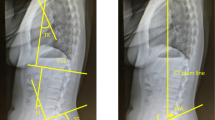Abstract
Background
The Japanese Orthopaedic Association has proposed the term locomotive syndrome (“locomo”) to designate a condition of individuals in high-risk groups with musculoskeletal disease who are highly likely to require nursing care. The specific characteristics of “locomo” must still be determined. The spinal column is a major and important component affected by “locomo,” but no literature has examined the relationship between spinal factors and “locomo.” The current study investigates the influence of spinal factors on “locomo” in the elderly.
Methods
A total of 135 subjects >70 years old were enrolled in the study (Yakumo study). Those answering yes to least one of the seven categories in the self-assessment checklist for “locomo” were defined as having “locomo.” We evaluated lateral lumbar radiographs, sagittal parameters, sagittal balance using the spinal inclination angle (SIA) as an index, spinal mobility as determined with SpinalMouse®, back muscle strength (BMS), and body mass index (BMI).
Results
Age, BMS, and SIA showed significant correlations with “locomo” and five of the seven self-assessment categories. Multivariate logistic regression analysis indicated that a decrease in BMS (OR 0.971, p < 0.001) and an increase in SIA (OR 1.144, p < 0.05) were significantly associated with “locomo.” BMS had significant negative correlations with age (r = −0.363), SIA (r = −0.294), and lumbar kyphosis (r = −0.254), and positive correlations with sacral slope angle (r = 0.194). SIA had significant negative correlations with BMS (r = −0.294), lumbar spinal range of motion (ROM) (r = −0.186) and total spinal ROM (r = −0.180), and positive correlations with age (r = 0.403) and lumbar kyphosis (r = 0.593).
Conclusions
A decrease in BMS and an increase in SIA may be the most important risk factors for “locomo.” Lumbar kyphosis is an important factor related to BMS and SIA. Back muscle strengthening and lumbar spinal ROM exercises could be useful for improving the status of an individual suffering from “locomo.”
Similar content being viewed by others
References
Nakamura K. The concept and treatment of locomotive syndrome: its acceptance and spread in Japan. J Orthop Sci. 2011;16:489–91.
Japanese Orthopaedic Association. Guidebook on locomotive syndrome. Tokyo: Bunkodo; 2010. (in Japanese).
Nakamura K. A “super-aged” society and the “locomotive syndrome”. J Orthop Sci. 2008;13:1–2.
Post RB, Leferink VJ. Spinal mobility: sagittal range of motion measured with the SpinalMouse, a new non-invasive device. Arch Orthop Trauma Surg. 2004;124:187–92.
Sakai Y, Matsuyama Y, Hasegawa Y, Yoshihara H, Nakamura H, Katayama Y, Imagama S, Ito Z, Ishiguro N, Hamajima N. Association of gene polymorphisms with intervertebral disc degeneration and vertebral osteophyte formation. Spine (Phila Pa 1976) 2007;32:1279–86.
Ishikawa Y, Miyakoshi N, Kasukawa Y, Hongo M, Shimada Y. Spinal curvature and postural balance in patients with osteoporosis. Osteoporos Int. 2009;20:2049–53.
Kado DM, Huang MH, Nguyen CB, Barrett-Connor E, Greendale GA. Hyperkyphotic posture and risk of injurious falls in older persons: the Rancho Bernardo Study. J Gerontol A Biol Sci Med Sci. 2007;62:652–7.
Lee CS, Lee CK, Kim YT, Hong YM, Yoo JH. Dynamic sagittal imbalance of the spine in degenerative flat back: significance of pelvic tilt in surgical treatment. Spine (Phila Pa 1976) 2001;26:2029–35.
Imagama S, Matsuyama Y, Hasegawa Y, Sakai Y, Ito Z, Ishiguro N, Hamajima N. Back muscle strength and spinal mobility are predictors of quality of life in middle-aged and elderly males. Eur Spine J. 2011;20:954–61.
Sinaki M, Itoi E, Rogers JW, Bergstralh EJ, Wahner HW. Correlation of back extensor strength with thoracic kyphosis and lumbar lordosis in estrogen-deficient women. Am J Phys Med Rehabil. 1996;75:370–4.
Sinaki M, McPhee MC, Hodgson SF, Merritt JM, Offord KP. Relationship between bone mineral density of spine and strength of back extensors in healthy postmenopausal women. Mayo Clin Proc. 1986;61:116–22.
Mika A, Unnithan VB, Mika P. Differences in thoracic kyphosis and in back muscle strength in women with bone loss due to osteoporosis. Spine (Phila Pa 1976) 2005;30:241–6.
Iki M, Saito Y, Kajita E, Nishino H, Kusaka Y. Trunk muscle strength is a strong predictor of bone loss in postmenopausal women. Clin Orthop Relat Res. 2006;443:66–72.
Miyakoshi N, Hongo M, Maekawa S, Ishikawa Y, Shimada Y, Itoi E. Back extensor strength and lumbar spinal mobility are predictors of quality of life in patients with postmenopausal osteoporosis. Osteoporos Int. 2007;18:1397–403.
Hongo M, Itoi E, Sinaki M, Miyakoshi N, Shimada Y, Maekawa S, Okada K, Mizutani Y. Effect of low-intensity back exercise on quality of life and back extensor strength in patients with osteoporosis: a randomized controlled trial. Osteoporos Int. 2007;18:1389–95.
Papaioannou A, Adachi JD, Winegard K, Ferko N, Parkinson W, Cook RJ, Webber C, McCartney N. Efficacy of home-based exercise for improving quality of life among elderly women with symptomatic osteoporosis-related vertebral fractures. Osteoporos Int. 2003;14:677–82.
Chien MY, Yang RS, Tsauo JY. Home-based trunk-strengthening exercise for osteoporotic and osteopenic postmenopausal women without fracture—a pilot study. Clin Rehabil. 2005;19:28–36.
Liu-Ambrose TY, Khan KM, Eng JJ, Lord SR, Lentle B, McKay HA. Both resistance and agility training reduce back pain and improve health-related quality of life in older women with low bone mass. Osteoporos Int. 2005;16:1321–9.
Miyakoshi N, Itoi E, Kobayashi M, Kodama H. Impact of postural deformities and spinal mobility on quality of life in postmenopausal osteoporosis. Osteoporos Int. 2003;14:1007–12.
Acknowledgments
The authors thank the staff of the Comprehensive Health Care Program held in Yakumo, Hokkaido. This study was supported by The Japanese Ministry of Health, Labor, and Welfare with Grant-in Aid for Scientific Research (B)(2)(15390455) and (B)(2)(20390397).
Conflict of interest
The authors declare that they have no conflict of interest.
Author information
Authors and Affiliations
Corresponding author
About this article
Cite this article
Hirano, K., Imagama, S., Hasegawa, Y. et al. Impact of spinal imbalance and back muscle strength on locomotive syndrome in community-living elderly people. J Orthop Sci 17, 532–537 (2012). https://doi.org/10.1007/s00776-012-0266-0
Received:
Accepted:
Published:
Issue Date:
DOI: https://doi.org/10.1007/s00776-012-0266-0




